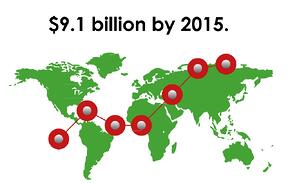 Still not sure about implementing Mobile Learning? Consider these eye-opening statistics published by different organizations such as ASTD, iPass, Towards Maturity and Ambient Insight. Data from their most recent surveys reveal some interesting facts that you might be interested in.
Still not sure about implementing Mobile Learning? Consider these eye-opening statistics published by different organizations such as ASTD, iPass, Towards Maturity and Ambient Insight. Data from their most recent surveys reveal some interesting facts that you might be interested in.
We’ve collected these facts about mobile learning to make the case for why everyone needs to take notice of the power of mobile in the learning industry. Let´s take a look:
1. In 2010, the top 5 adopters of mLearning were the U.S., Japan, South Korea, and Taiwan. Together these 5 countries accounted for about 70% of the 2010 market. By 2015 they will account for only 40% with the highest growth rates in China, India, Indonesia, and Brazil. (Ambient Insight’s Market Report on mLearning)
2. By 2015, 80% of people accessing the Internet will be doing so from mobile devices. (2011 Horizon Report)
3. According to American Ambient Insight Report 2011, 39% of organizations were already making use of mobile learning. Additionally they reported a growth rate of 29.3% among US corporations buying mobile learning, including the large ones, like IBM, Kraft and Pepsi.
4. US Leads the Global Mobile Learning Market. In the 2010 market, the US was the top Mobile Learning buying country, followed by Japan, South Korea, the UK, China, and Taiwan. By 2015, the top buying countries will be the US, China, India, Japan, Indonesia, and Brazil, respectively. (The Worldwide Market for Mobile Learning Products and Services: 2010-2015 Forecast and Analysis)
5. Ambient Insight reports a surging global mobile learning market. The countries with the highest growth rates (all over 60%) are China, India, and Indonesia. The countries with the lowest growth rates (all under 5%) are Japan, South Korea, and Taiwan, the three most mature Mobile Learning markets on the planet.
 6. Mobile Learning Market to reach $9.1 billion by 2015. The worldwide market for Mobile Learning products and services reached $3.2 Billion in 2010. The five-year compound annual growth rate (CAGR) is 22.7% and revenues will reach $9.1 billion by 2015. (Ambient Insight Mobile Learning Market Forecast 2009-2014)
6. Mobile Learning Market to reach $9.1 billion by 2015. The worldwide market for Mobile Learning products and services reached $3.2 Billion in 2010. The five-year compound annual growth rate (CAGR) is 22.7% and revenues will reach $9.1 billion by 2015. (Ambient Insight Mobile Learning Market Forecast 2009-2014)
7. Smartphone is the ultimate favorite. If mobile workers could choose only one device, 46 % of them would pick a smartphone over a tablet or a laptop as their favorite one. The iPhone still trumps other mobile devices, with 30% of mobile workers selecting it if they had only one choice, followed by an iPad (22%) and a laptop (21%). (The iPass Global Mobile Workforce Report March, 2012)
8. In the final quarter of 2010 Fortune reported that Smartphones outsold PC’s for the first time, a full two years before the prediction by Morgan Stanley. Moreover, Gartner's predicted that by 2013, mobile phones will overtake PCs as the most common Web access deviceworldwide.
9. Tremendous growth in the number of new mobile devices, specifically tablets, expected over the next few years. Gartner predicted world wide rollout of 103.4 million in 2012 and 154.2 million in 2013.
10. Growing Mobile Workforce. It is estimated that 75% of the workforce in the US is already mobile and IDC predicts that by 2015 the numbers, worldwide, will reach 1.3 billion or a staggering 37.2% of global workforce.

11. Mobile is booming, and mLearning is following along. The 2011 Mobile Learning Guild Research indicates that companies are progressing on the mobile front, and while the initiatives are as yet small, the trends are for more activity. They see an increase in percentage of companies that plan to do more mLearning from 38.5% in 2007 to 51% in 2011.
13. Mobile research by benchmarking company, Towards Maturity, highlights how over 70% of companies from the Towards Maturity Benchmark Study 2012-2013 of 500 organisations, are planning to implement m-learning in the next 2 years.
14. Poor evaluation. Less than 10% of respondents who deliver mobile learning have formal metrics in place to evaluate effectiveness. (ASTD Mobile Learning – Delivering Learning in a Connected World. 2012)
15. According to the eLearning Guild’s Mobile Learning: The Time Is Now Report, the number of Guild members who say they intend to use mLearning continues to increase. In 2010, 45.6% of Guild members said they intend to do more mLearning. In 2012, that figure has increased to 65.7%.
16. More benefits. Organizations using mobile technologies in learning are reporting more staff and business benefits than those who are not: 29% of mobile users agree that learners put what they learn into practice quickly (compared to 24% of non-mobile users). Towards Maturity Benchmark Study 2012-2013
17. Top uses of mobile in learning: Easily accessible reference material, performance support, and video are the top 3 usage of mobile devices. ASTD research on Mobile Learning
18. The mobile stack (average number of devices carried by a mobile worker) has grown to 3.5, up from 2.7 in 2011. (The iPass Global Mobile Workforce Report 2012)
19. The industry sectors with the highest use of mobile devices are: Consultancy (80%); Commercial training providers (60%); Further and higher education (55%) and IT and telecoms (55%). Private sector organizations are more likely to be using m-learning than those in the public or not-for-profit sectors. Towards Maturity Benchmark Study 2012-2013
20. The world of work is increasingly collaborative. Market intelligence firm IDC notes that about one billion people fit the definition of mobile workers already, and projects that fully one-third of the global workforce — 1.2 billon workers-- will perform their work from multiple locations by 2013. (2011 Horizon Report)
That's quite a bit of enlightening data, huh? Which data points from these studies did you find most interesting?









